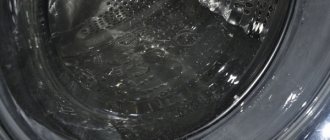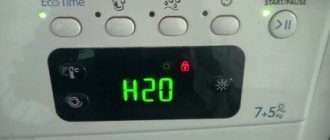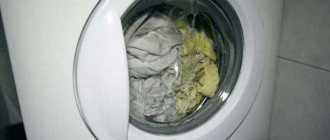The washing machine can break down at any time. The cause of the breakdown can be anything - an electronics failure, torn things, a cracked tank, etc. Before calling a repairman, you need to drain the water and remove the clothes. The material contains popular ways to solve the problem, as well as tips for caring for your washing machine.
How to drain water from a washing machine yourself: 5 ways
There are several ways to drain water from a broken washing machine.
Even a person unfamiliar with the technical structure of the unit can cope with this task. Required:
- washing machine operating instructions,
- a large but low basin/bowl and floor rags,
- physical strength and ingenuity.
Draining your washing machine manually can be time-consuming and labor-intensive. In addition, there is a risk of making a mistake. However, situations are different. It is not always possible to wait for a washing machine repairman to arrive, but the water needs to be drained urgently.
How to independently, quickly and competently drain the water from the washing machine, so as not to harm the equipment and not aggravate the breakdown situation?
Can it be placed directly into the drum?
There is a myth that by pouring washing powder directly into the drum of the washing machine, you can reduce detergent consumption.
In fact, this is not true. If washing powder is mixed with water in measured doses from the powder receptacle, the detergent is washed out of the washing machine drum very quickly, which has an extremely negative effect on the quality of the wash.
Also, pouring powder into the drum increases the risk of laundry damage (undissolved particles of bleaching substances can cause whitish spots and streaks on colored fabrics).
You can pour powder into the drum of the Indesit washing machine only in exceptional cases:
- there is a problem of lack of water pressure (as a result, the washing powder remains in the powder receiver tray);
- Due to internal problems, the washing machine does not pick up the detergent poured into the tray.
A special dispenser will help you pour washing powder into the drum correctly (without negative consequences for laundry and household appliances). This is a small plastic jar with a large number of holes in the lid.
The dispenser is filled with detergent and then placed inside the drum along with dirty clothes. The powder is gradually mixed with water through the holes of the dispenser, thereby ensuring maximum washing quality.
Features of forced drainage of water from the washing machine
There are 5 ways
Drain the washing machine if it has not completed this washing step on its own.
This is done via:
- Drain hose.
- Drain filter.
- Emergency drain hose.
- Luke.
- Drain pipe.
But:
- not every method will suit a specific model of washing machine,
- it is not always physically possible to do this,
- the danger of a “flood” exists, even if everything is done correctly,
- It is very important to follow safety precautions when handling the washing machine!
When you first discover that the washing machine has stopped the washing process but has not drained the water, the first thing to do is turn it off
!
Important!
With dry hands, remove the plug from the socket! Only then proceed to inspect the car.
Disconnecting an electrical appliance (which is a washing machine) from the network eliminates the risk of electric shock!
Recommendations for housewives and home craftsmen
An impressive list of breakdowns and machine stops without completing the program can be easily prevented by following the simplest operating rules:
- Before loading items into the drum, remove all contents from pockets . Particularly harmful to the unit are coins, paper clips, earrings, rings, small luggage keys and similar metal objects.
- Check the tightness of the buttons and zippers . Before immersing clothes prepared for washing, zippers and buttons must be fastened.
- Use a brush to clean out dust and sand under lapels and in pockets..
- Before washing curtains, remove the hooks that connect them to the wheels of the curtain rod.
Do not forget that a washing unit is a complex technical device that requires careful handling.
It will be useful to put thin linen and items with lint in mesh bags, specially produced for washing in machines. Instead, it is permissible to use thin fabric or a bag sewn from it yourself.
We regularly clean the drain system filter at the intervals specified by the manufacturer.
If we load a lot of worn-out laundry into the drum, clean the filter after each wash.
Reasons why water does not drain in a washing machine
The lack of drainage in the washing machine is a consequence of an unusual situation.
If the washing machine stops draining water:
1.You have selected
non-draining
wash cycle , such as delicate wash or woolen wash.
Solution.
Check if you have a special mode installed. Information about modes that do not involve draining water is contained in the instructions for the washing machine.
2.
The drain hose is pinched.
The drain hose connects the machine to the sewer. It may be twisted or pinched. Water physically cannot go down the drain.
Solution.
Move the drain hose to the proper position and try to start the water drain mode.
3.Clogged
drain filter or sewer.
Solution.
You can remove the blockage yourself or invite a washing machine repairman.
4. Out of order
pressure switch (water level sensor), control board or pump pump. These parts can only be repaired or replaced with new ones by a professional technician.
Solution.
Order a washing machine repair service and try draining the water from the unit yourself before the technician arrives.
Additionally
After getting rid of the water, conduct a test run . If the device does not function normally, you need to understand the cause of the breakdown.
You should check whether the pump impeller, located behind the filter, rotates freely and remove any foreign objects that are interfering with it, if any . Next, set the spin mode and shine a flashlight into the filter hole. If the impeller still does not rotate, the drain pump needs to be replaced. To do this, remove the drain assembly and detach the old drain pump and wires from it. The new pump is placed in place of the old one and the wires are attached to it.
In addition, the cause of the problem could be a software glitch or the electronic module could break.
In the first case, the machine with the drained water needs to be dried for a while and then started again. In the second, you need to solder the tracks or replace the relays and triacs responsible for the operation of the drain mechanism. In some situations it is necessary to change the module.
Draining water through a hose or pump filter
These are the two best ways, both quick and easy.
Drain hose
connected to the back wall of the washing machine and put into the sewer. It is usually corrugated and gray in color.
To drain the water:
- Disconnect the hose from the sewer.
- Place it in a pre-prepared large bowl/basin and hold it there. Water will begin to flow out.
Drain pump filter
located at the bottom of the front panel of the washing machine under a decorative hatch or panel.
To drain the water:
- Open the decorative hatch/panel. You will see a round filter.
- Tilt the car back slightly and lean it against the wall.
- Place a container under the drain filter to collect water.
- Turn the filter handle counterclockwise, but do not unscrew it! The water will flow.
A washing machine is a bulky unit. Be careful and careful when handling it to avoid household injuries!
Unscrew the plug of the garbage filter
Any Indesit washing machine is equipped with a special filter that prevents foreign objects from entering the pump - coins, paper, paper clips. It is very easy to access the filter element - it is located on the front of the machine, in the lower right corner behind the false panel. Algorithm of actions when draining water through a garbage filter:
- Using a slotted screwdriver, release the latches and remove the decorative panel;
- tilt the washer slightly on its left side, carefully lean the body against the wall and place a basin under the bottom to collect the liquid. Make sure that the machine does not slip;
- cover the floor around the SMA with rags that absorb water well;
- Unscrew the filter a few turns until water flows out from under the plug. There is no need to completely remove the filter element from the system;
- collect the liquid in a container.
Unfortunately, it will be very difficult to ensure a “clean” drainage of water in this case; some of the liquid will still spill. The floor will have to be wiped by hand. But there is also a significant advantage of this method - the whole process will take very little time, since you do not have to disassemble the washing machine.
Drain directly through the hatch
Opening the machine and scooping water out of it manually is perhaps the first thing that comes to mind when such a problem arises. This is not the best way, but acceptable if the first two did not work.
Note! Not every model of washing machine will unlock the hatch after being turned off. If the door does not open, this option is not suitable for you.
If the water level in the tank of the machine is higher than the hatch, when it is opened, it will rush out in a stream. To avoid this, tilt the unit body back towards the wall, and then open it.
Emergency hose
Most washing machines have a special emergency drain hose hidden behind a small hatch on the front of the unit. To drain water through it, follow these steps:
- Get the hose.
- Remove the plug from the hose and pour water into the container provided. It has a small diameter, so the process takes a long time.
Draining through the drain pipe
This is the most time-consuming and undesirable option for forcibly draining water from the washing machine.
To drain the water:
- Detach the back panel of the washing machine.
- Locate the drain pipe under the drum. It connects to the pump.
- Place a bowl under the pipe and place rags nearby.
- Remove the clamp from the pipe and disconnect it from the pump. The water will flow in a stream. If not, there is a blockage in the pipe.
Certified and experienced technician
VseRemont24 service center will cope with the task of draining water from the washing machine quickly and efficiently. You can safely entrust this task to him, as well as all subsequent repairs necessary to the washing machine.
Call a technician to your home if your machine stops draining water! After a couple of hours of work by the technician, it will work properly again!
Why doesn't the equipment drain the water?
Causes of problems in Ariston:
- Program crash. Perhaps there was a network overvoltage or a power outage, which allowed the Ariston machine to “think” about performing the task at hand, specifically about draining, or to stop working completely. Knocking on the top cover or the presence of heavy objects similarly cause a malfunction, which also stops the drain.
- The drain hose is blocked by foreign objects.
- Clogged sewer system.
- Foreign objects have entered the filter.
- Pump or pump failure.
- Extension of the hose or placement at an unacceptable level.
- Wiring open or shorted.
Some of the problem can be solved yourself, while the machine will remain in working order. The owner of Ariston is lucky if his machine is equipped with the Smart diagnostic function. Using special keys, Wi-Fi and a smartphone, the machine is diagnosed, and after a few seconds a notification is received about the breakdown, the possible cause and how to fix it. This option is factory-installed, but is installed in more modern Ariston models.
What to do if Smart diagnostics is not provided by the manufacturer? Then all that remains is to conduct an independent inspection of the equipment, finding out why the drain is not working. Some Ariston models equipped with an electronic display may display an error code, which will simplify the search, but this function does not work on mechanics.
Quantity
The amount of powder required for high-quality washing is determined by the following factors:
- amount of dirty clothes (1 tbsp of powder is enough for 1 kg of dry laundry);
- degree of soiling of the laundry (the more stains, the greater the powder consumption);
- water hardness indicator (high-quality washing in soft water requires less powder than in hard water);
- a specified washing program (in order to wash things in the “cotton” mode, you will need at least 6 tablespoons of powder, and in the “synthetic” mode, only 3 tablespoons of detergent).
Detailed information about the standards for using washing powder can be found on the manufacturer's packaging. Such recommendations should not be ignored.
Exceeding the norm is fraught with problems with drainage (foam, particles of undissolved powder clog the hoses). Also, do not reduce consumption. Saving powder means poor washing quality.
Fluid Removal Options
It is safest to empty the washing machine in automatic mode - through the provided one. Everything is simple here: scroll the selector to the appropriate position and start the cycle. However, if the system freezes, this option does not work. If the “tidy” does not respond to the user’s commands, you will have to forcefully drain the water manually. “Manual” draining is started in the following ways:
- through the drainage sleeve, by gravity;
- unscrewing the garbage filter;
- emergency “opening” of the hatch;
- by uncoupling the pipe connecting the tank and the volute.
Before forced draining, equipment should be disconnected from communications: power supply and water supply.
Each of the forced options has its own risks and benefits. Much depends on the situation - sometimes only “opening” the drum is possible. In any case, you first need to turn off the power to the machine, turn off the water and assess the scale of the situation, and then choose the appropriate drainage method.
The pipe between the volute and the drum
If the previous methods did not help, the last method remains is to forcefully empty the washer through the drum pipe. This option is more complicated, but more effective: all the liquid will be drained from the tank. It is also possible to eliminate the cause of the stagnation, since often the problem lies in a clogged hose. How to drain?
- Remove the back wall of the case.
- Find the pipe connecting the tank and the pump.
- Place a deep container and apply a cloth.
- Loosen the clamp holding the pipe.
- Remove the hose from the pump fitting and lower it into a container.
If water does not flow out when you disconnect the hose from the pump, then the problem is a blockage. You will have to loosen the second clamp and unhook the pipe from the tank. After draining, we clean the element and return it to its place.
Getting to the tank with the pipe is quite difficult. You should move the machine away from the wall, gain access to the bottom of the washing machine, crawl up to the drum, and only then, moving by touch, get down to business. Emptying the washing machine is only the first stage of repair. Afterwards there will be diagnostics, searching for the causes of the failure and eliminating the stagnation.
Source











